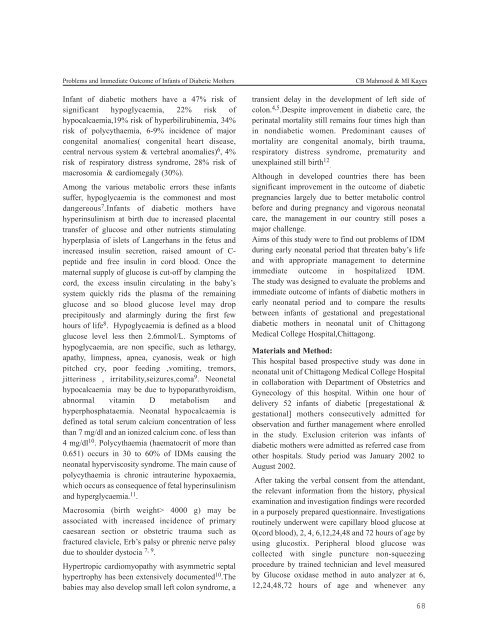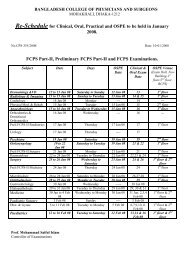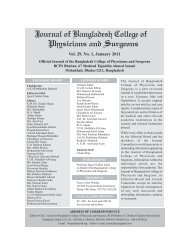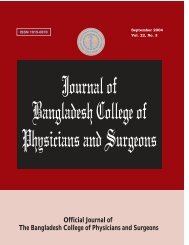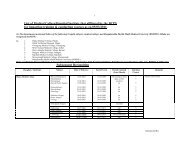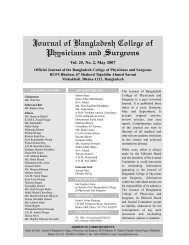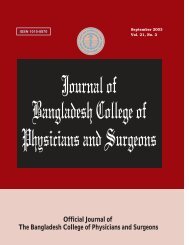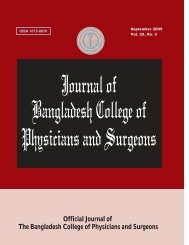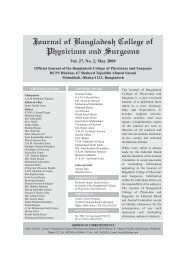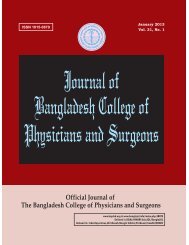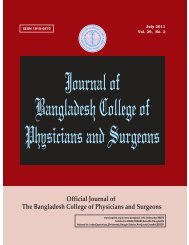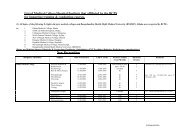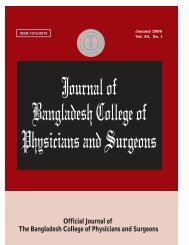May 2008 - bcps
May 2008 - bcps
May 2008 - bcps
You also want an ePaper? Increase the reach of your titles
YUMPU automatically turns print PDFs into web optimized ePapers that Google loves.
Problems and Immediate Outcome of Infants of Diabetic MothersInfant of diabetic mothers have a 47% risk ofsignificant hypoglycaemia, 22% risk ofhypocalcaemia,19% risk of hyperbilirubinemia, 34%risk of polycythaemia, 6-9% incidence of majorcongenital anomalies( congenital heart disease,central nervous system & vertebral anomalies) 6 , 4%risk of respiratory distress syndrome, 28% risk ofmacrosomia & cardiomegaly (30%).Among the various metabolic errors these infantssuffer, hypoglycaemia is the commonest and mostdangereous 7 .Infants of diabetic mothers havehyperinsulinism at birth due to increased placentaltransfer of glucose and other nutrients stimulatinghyperplasia of islets of Langerhans in the fetus andincreased insulin secretion, raised amount of C-peptide and free insulin in cord blood. Once thematernal supply of glucose is cut-off by clamping thecord, the excess insulin circulating in the baby’ssystem quickly rids the plasma of the remainingglucose and so blood glucose level may dropprecipitously and alarmingly during the first fewhours of life 8 . Hypoglycaemia is defined as a bloodglucose level less then 2.6mmol/L. Symptoms ofhypoglycaemia, are non specific, such as lethargy,apathy, limpness, apnea, cyanosis, weak or highpitched cry, poor feeding ,vomiting, tremors,jitteriness , irritability,seizures,coma 9 . Neonetalhypocalcaemia may be due to hypoparathyroidism,abnormal vitamin D metabolism andhyperphosphataemia. Neonatal hypocalcaemia isdefined as total serum calcium concentration of lessthan 7 mg/dl and an ionized calcium conc. of less than4 mg/dl 10 . Polycythaemia (haematocrit of more than0.651) occurs in 30 to 60% of IDMs causing theneonatal hyperviscosity syndrome. The main cause ofpolycythaemia is chronic intrauterine hypoxaemia,which occurs as consequence of fetal hyperinsulinismand hyperglycaemia. 11 .Macrosomia (birth weight> 4000 g) may beassociated with increased incidence of primarycaesarean section or obstetric trauma such asfractured clavicle, Erb’s palsy or phrenic nerve palsydue to shoulder dystocia 7, 9 .Hypertropic cardiomyopathy with asymmetric septalhypertrophy has been extensively documented 10 .Thebabies may also develop small left colon syndrome, aCB Mahmood & MI Kayestransient delay in the development of left side ofcolon. 4,5 .Despite improvement in diabetic care, theperinatal mortality still remains four times high thanin nondiabetic women. Predominant causes ofmortality are congenital anomaly, birth trauma,respiratory distress syndrome, prematurity andunexplained still birth 12 .Although in developed countries there has beensignificant improvement in the outcome of diabeticpregnancies largely due to better metabolic controlbefore and during pregnancy and vigorous neonatalcare, the management in our country still poses amajor challenge.Aims of this study were to find out problems of IDMduring early neonatal period that threaten baby’s lifeand with appropriate management to determineimmediate outcome in hospitalized IDM.The study was designed to evaluate the problems andimmediate outcome of infants of diabetic mothers inearly neonatal period and to compare the resultsbetween infants of gestational and pregestationaldiabetic mothers in neonatal unit of ChittagongMedical College Hospital,Chittagong.Materials and Method:This hospital based prospective study was done inneonatal unit of Chittagong Medical College Hospitalin collaboration with Department of Obstetrics andGynecology of this hospital. Within one hour ofdelivery 52 infants of diabetic [pregestational &gestational] mothers consecutively admitted forobservation and further management where enrolledin the study. Exclusion criterion was infants ofdiabetic mothers were admitted as referred case fromother hospitals. Study period was January 2002 toAugust 2002.After taking the verbal consent from the attendant,the relevant information from the history, physicalexamination and investigation findings were recordedin a purposely prepared questionnaire. Investigationsroutinely underwent were capillary blood glucose at0(cord blood), 2, 4, 6,12,24,48 and 72 hours of age byusing glucostix. Peripheral blood glucose wascollected with single puncture non-squeezingprocedure by trained technician and level measuredby Glucose oxidase method in auto analyzer at 6,12,24,48,72 hours of age and whenever any68


